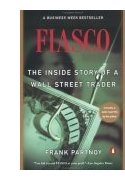| |
Fiasco: The Derivatives Market Explained
(March 9, 2007)
  An astute reader highly recommended
Fiasco: The Inside Story of a Wall Street Trader
An astute reader highly recommended
Fiasco: The Inside Story of a Wall Street Trader (even offering to send me a copy), and I can now report that the recommendation was
fully justified: if you want to understand what derivatives are, and how the derivatives
market will unravel, erasing trillions in wealth, this is the book for you.
(even offering to send me a copy), and I can now report that the recommendation was
fully justified: if you want to understand what derivatives are, and how the derivatives
market will unravel, erasing trillions in wealth, this is the book for you.
Even though the author's account was written in the mid-90s, the basics of how derivatives
are constructed, sold and unravel are the same; indeed, the author's (a former derviatives
trader/salesman at Morgan Stanley) description of derivatives meltdowns in 1994 (Procter and Gamble take
a $100 million loss) and 1995 (the collapse of Barings Bank) are eerily prescient of the
risks facing the $360 trillion global derivatives market.
Of the many revelations in this book, I'll mention just a few.
Derivatives are unbelievably widespread. Gibson Greetings Cards Company suffered
a derivatives meltdown in 1994, along with Procter and Gamble (talk about an appropriate
name); you have to wonder, what were a greeting card and consumer company doing with
derivatives? It's understandable that a global company like P&G would have currency hedges,
but complex derivatives? Even back then, when the derivatives market was a tiny percentage of
what it is today, name-brand firms such as Chrysler owned $2.5 billion in derivatives, as
did small midwest insurance companies, mutual funds and teachers pensions funds. One has to wonder
who doesn't own derivatives. And don't expect to find any mention in a company's or
a mutual fund's financial statements; the derivatives are held "off-balance sheet."
In other words, you as a shreholder will never know the extent to which your supposedly safe
insurance company, pension fund or mutual fund is leveraged.
Many derivatives are so complex that even the banks who package and sell them have
a difficult time assessing their value. A typical derivative might tie bonds priced
in Mexican pesos with three currencies; depending on what each of the three currencies did
(rise or fall) and the value of the underlying Mexican bonds, the derivatives could rise in
value or fall to zero.
Most of the buyers of derivatives have a poor grasp of the risks. Here is the
really pernicious part of a low-interest rate environment: supposedly
conservatives institutions like life insurance companies and pension funds are so desperate
to earn more than 4% on their money that they're easy prey for derivatives promising even a
"point" (1%) higher return.The downside--a 100% loss--is naturally glossed over as "unlikely."
A nice thought, but if the geniuses in the banks earning tens of millions in fees can't
price the derivative value without complex computer programs, then how is a pension fund
going to calculate the true risks buried in their derivative portfolio?
There are myriad obscure tripwires lurking in derivatives. This is how the global
derivatives market will blow up: the Swedish Kroner (for example) will unexpectedly fall
or rise, causing some obscure derivatives to blow up. The sellers have to dump other assets
to cover the loss--other derivatives, stocks and bonds--which trigger further fluctations
in currencies and bond values which then trip up other derivatives. As these complex
financial instruments start to
unravel, owners of derivatives who thought they were "hedged" (insured) against fluctuations
find instead that they're victims of permutations they never properly understood.
If you've ever wondered exactly what a derivative is, or what all the fuss is about, then
read this book. There may be better explanations of the derivatives trade, but I haven't
come across any others written for the layperson. If you know of any, by all means let me know.
For more on this subject and a wide array of other topics, please visit
my weblog.
copyright © 2007 Charles Hugh Smith. All rights reserved in all media.
I would be honored if you linked this wEssay to your site, or printed a copy for your own use.
|
|


